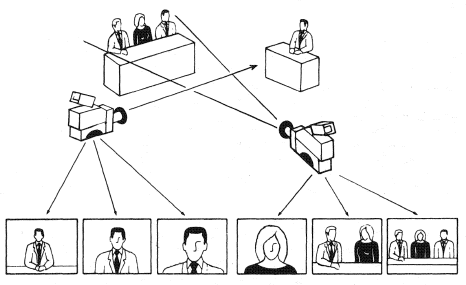Production Formats
If you compare similar types of program from all over the world, you will find remarkable similarities in the ways they are presented. From formal interviews to cookery demonstrations, from newscasts to talk shows, they appear to have comparable settings, shots, and modes of approach.
Regular formats
Some kinds of production have settled down to a particular format, because this approach works best. others have become conventions. You could have a weatherman out in the street with an umbrella, or leaping around on a floor map. It has been tried. But in the end, there is much to be said for a person pointing to a map or animated chart. It is less distracting, and simpler, and in the end does the job better.
We could present a quiz show in a lounge setting, with armchairs and sofa, grouped around a TV set; the guests answering the questioner on the screen. Would this be an innovation, or a cranky way of staging a familiar subject? WouId it offer the range of shot variations that the more formal method opposite provides? How would the costs and facilities needed compare? Would there be sound pickup or lighting problems? These are the sort of considerations that influence how one presents the subject.
Yesterday’s novel approach often becomes today’s routine. Changes develop partly through style, and partly through technology. Once interviews were invariably formal, and took place in a two-chair or chair-and-desk setup. But now camera and microphone are free to go anywhere. Mobile interviews while walking through city streets or countryside, or in a factory, are now commonplace. In the studio, the deskbound interviewer often talks to someone miles away, through a nearby TV screen, or an electronically inserted picture.
The different approach
So how do we get away from formats and routines? opinions vary. You can do so by introducing variety. Instead of intercutting static shots, you may introduce developing shots that vary the cameras’ viewpoints.
Instead of having a garden expert talking direct to camera, someone out of shot can talk to him as we watch him cleaning off his spade, or preparing to sow seeds. Any ‘business’ that appears to be in character, and naturally motivated, can help to get away from formality, and put the guest at ease.
Be imaginative, but avoid gratuitous gimmicks unless they really do add something to the program. Reflections in water, star filters, heavily filtered skies, tapping feet, shooting through prominent foreground flowers… quickly become recognizable devices. Fashions come and go!
Static shooting
Where cameras are located at fixed vantage points and achieve shot variations only by changing lens angles, regular routine treatments often develop.

Dynamic shooting
Where camera positions are varied to provide viewpoint changes, repetitive shots are readily avoided.

